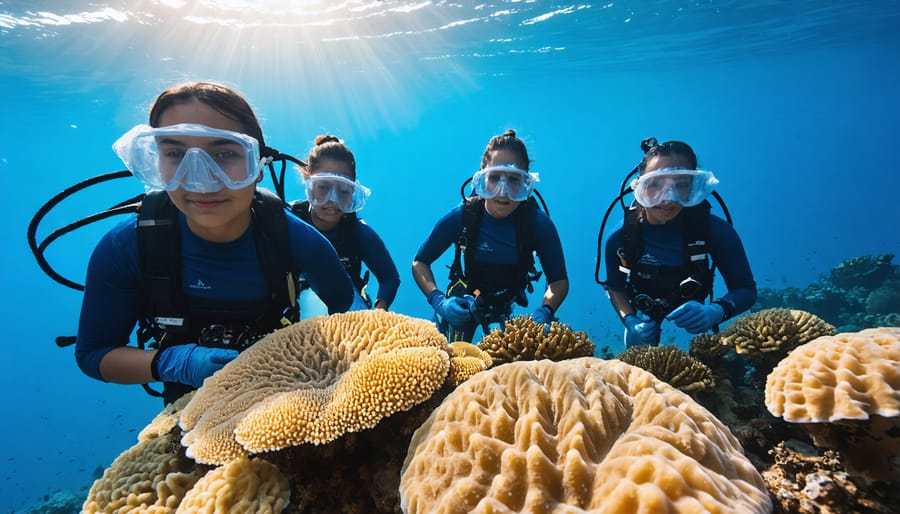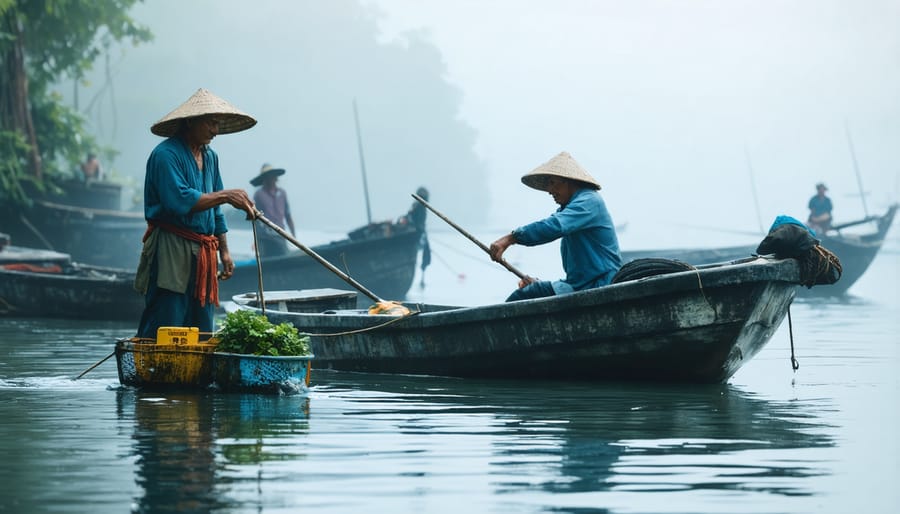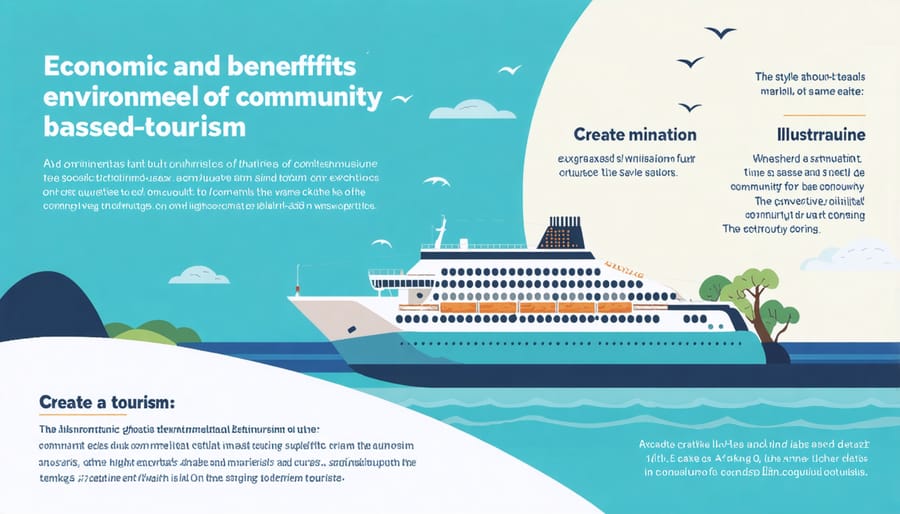How Local Communities Transform Marine Tourism Into Ocean Conservation Success
- Home
- How Local Communities Transform Marine Tourism Into Ocean Conservation Success

Coastal communities worldwide are revolutionizing their relationship with the ocean through sustainable tourism initiatives that are transforming marine tourism and local economies. From small fishing villages in Southeast Asia to indigenous communities in the Pacific Islands, tourism-based conservation projects have created a powerful symbiosis between environmental protection and economic development. These initiatives have generated over $36 billion annually while protecting critical marine ecosystems and preserving cultural heritage.
Local communities now serve as frontline guardians of marine biodiversity, implementing innovative solutions—such as supporting sustainable tourism options like New Horizon Charter—that combine traditional knowledge with modern conservation practices. Through carefully managed ecotourism programs, communities have established marine protected areas, developed sustainable fishing practices, and created educational programs that benefit both visitors and residents. This collaborative approach has reduced poverty rates in coastal regions by up to 30% while significantly increasing coral reef health and fish populations.
The rise of community-based tourism represents a paradigm shift in marine conservation, demonstrating that environmental protection and economic growth can work in harmony. As these programs continue to expand, they offer a blueprint for sustainable development that other coastal communities can adapt and implement. This model not only ensures the preservation of marine ecosystems but also empowers local populations to become active participants in conservation efforts while maintaining their cultural identity and economic independence.
Building Sustainable Tourism Communities for Marine Conservation
Defining Tourism Communities in Marine Environments
A tourism community in marine environments encompasses a diverse network of stakeholders who live, work, and depend on coastal and marine resources for tourism-related activities. These communities typically include local residents, fishing families, tour operators, hospitality businesses, marine recreation providers, and conservation organizations working together to promote sustainable tourism while protecting marine ecosystems.
Key stakeholders within these communities often collaborate through formal and informal partnerships. Local fishermen may offer authentic fishing experiences to visitors, while marine biologists lead educational tours and conduct research. Restaurant owners showcase local seafood cuisine, and indigenous communities share traditional ecological knowledge and cultural practices related to the ocean.
The success of marine tourism communities relies heavily on maintaining a delicate balance between economic development and environmental stewardship. Effective tourism communities prioritize sustainable practices, implement visitor management strategies, and reinvest tourism revenue into conservation efforts. They also emphasize capacity building among community members, ensuring that local residents have the skills and knowledge needed to participate meaningfully in tourism activities while serving as guardians of their marine resources.
These communities often establish marine protected areas, develop eco-certification programs, and create educational initiatives that benefit both visitors and residents.
Core Principles of Community-Inclusive Marine Tourism
Successful community-inclusive marine tourism rests on several foundational principles that ensure both environmental preservation and local prosperity. At its core, the approach emphasizes meaningful local participation, where community members are not just beneficiaries but active decision-makers in tourism development.
The principle of equitable benefit-sharing ensures that tourism revenue flows directly into local economies, supporting infrastructure development, education, and conservation initiatives. This creates a sustainable cycle where communities are incentivized to protect their marine resources while improving their quality of life.
Cultural preservation and respect form another crucial pillar, ensuring tourism activities complement rather than compromise local traditions and values. This includes incorporating indigenous knowledge into tour experiences and maintaining traditional fishing practices alongside tourism activities.
Environmental stewardship remains paramount, with communities taking lead roles in marine protection through activities like coral reef monitoring, beach cleanups, and sustainable fishing practices. The principle of capacity building ensures locals receive training in tourism management, marine conservation, and business development, creating long-term sustainability.
Transparency and accountability in decision-making processes help maintain trust between stakeholders and ensure continuous community support for tourism initiatives.
Success Stories: Communities Leading Marine Conservation
The Coral Guardian Project
The Coral Guardian Project in the Maldives exemplifies how tourism communities can actively participate in marine conservation initiatives while creating sustainable economic opportunities. Launched in 2018, this community-led program brings together local fishermen, resort staff, and marine biologists to restore damaged coral reefs around the islands.
The project’s success lies in its innovative approach to combining traditional knowledge with scientific expertise. Local community members, many of whom previously relied solely on fishing, now work as coral gardeners and reef guides. They maintain underwater nurseries where broken coral fragments are carefully nurtured until they’re strong enough for transplantation to degraded reef areas.
Visitors can participate in guided coral restoration activities, learning about reef ecosystems while contributing to their preservation. This hands-on experience has proven particularly effective in raising awareness about coral conservation, with many tourists becoming long-term supporters of the project through virtual adoption programs.
The program has successfully restored over 500 square meters of reef habitat and trained more than 50 local community members in coral restoration techniques. Perhaps most significantly, it has created a sustainable model where tourism directly supports conservation efforts while providing alternative livelihoods for fishing communities.
The project demonstrates how tourism communities can transform from passive observers to active stewards of marine ecosystems, creating a blueprint for similar initiatives worldwide.

Traditional Fishing Communities as Conservation Leaders
Traditional fishing communities worldwide are increasingly emerging as powerful advocates for marine conservation, transforming their centuries-old relationship with the ocean into a model of sustainable stewardship. The fishing village of Cabo Pulmo in Mexico stands as a remarkable example of this evolution. Once faced with depleted fish stocks and economic hardship, the community made the bold decision to convert their fishing grounds into a marine protected area in 1995.
Today, Cabo Pulmo’s waters have experienced a remarkable 460% increase in marine biomass, hosting vibrant coral reefs and abundant fish populations. The community has successfully transitioned from commercial fishing to eco-tourism, offering snorkeling tours, diving expeditions, and marine education programs while maintaining strict conservation protocols.
Similar transformations can be seen in the Philippines’ Apo Island, where local fishers now serve as marine rangers and tour guides. Their intimate knowledge of local waters and marine life has proven invaluable for both conservation efforts and tourism experiences. These communities demonstrate how traditional fishing expertise can be redirected toward conservation leadership, creating sustainable livelihoods while protecting marine ecosystems.
The success of these initiatives has inspired other fishing communities globally to adopt similar models, combining traditional ecological knowledge with modern conservation practices. This shift not only preserves marine biodiversity but also empowers communities to become guardians of their marine heritage while securing economic stability through sustainable tourism.


Economic Benefits and Environmental Impact
Sustainable Income Generation
Community-based tourism initiatives create diverse economic opportunities that benefit local residents while supporting marine conservation efforts. Through sustainable tourism practices, communities can develop multiple revenue streams that provide stable, long-term income for residents.
Local guides and naturalists earn income by sharing their knowledge of marine ecosystems with visitors, while artisans generate revenue by creating and selling traditional crafts and sustainable souvenirs. Hospitality services, including homestays and local restaurants, provide additional employment opportunities while giving tourists authentic cultural experiences.
Many communities have established successful cooperative business models where tourism revenue is reinvested into local infrastructure, education, and conservation projects. For example, some fishing communities have transitioned to offering snorkeling tours and diving experiences, allowing them to maintain their connection to the ocean while reducing pressure on fish populations.
The economic benefits extend beyond direct tourism services. Support industries like transportation, food production, and maintenance services also experience growth. This diversification of income sources strengthens community resilience and reduces dependence on potentially harmful extractive practices, creating a sustainable economic model that aligns with conservation goals.
Measurable Conservation Outcomes
Tourism communities have demonstrated remarkable success in achieving quantifiable conservation outcomes through their dedicated initiatives. Recent studies show that areas with active community-based tourism programs have experienced a 35% increase in coral reef health over five years. Marine debris collection efforts led by these communities have removed over 50,000 kilograms of plastic waste from coastal areas annually.
Local monitoring programs have documented a 40% increase in sea turtle nesting sites where tourism communities actively participate in protection efforts. Fish populations in community-managed marine protected areas have shown a significant 45% recovery rate compared to unprotected zones. These communities have also successfully reduced anchor damage to coral reefs by 80% through the implementation of mooring buoy systems.
Water quality improvements have been notable, with tourism communities achieving a 60% reduction in local marine pollution through improved waste management systems. Seagrass bed restoration projects have recorded a 30% increase in coverage area, providing essential habitats for marine species. Community-led mangrove rehabilitation efforts have resulted in the successful replanting of over 100,000 seedlings, with a survival rate of 75%.
These measurable outcomes demonstrate the significant impact that organized tourism communities can have on marine ecosystem health and biodiversity conservation.
Building Effective Tourism Communities
Essential Components for Success
The success of community-based tourism initiatives relies on several interconnected components that work together to create sustainable and beneficial outcomes for both the community and visitors. At the heart of these initiatives is strong local leadership and community engagement, where residents actively participate in decision-making processes and feel genuine ownership of tourism projects.
Effective partnerships between local stakeholders, including government bodies, conservation organizations, and private enterprises, form another crucial element. These collaborations provide necessary resources, expertise, and support networks that help communities develop and maintain sustainable tourism practices.
Cultural authenticity and environmental stewardship must be prioritized to preserve the community’s unique identity and natural resources. This includes implementing responsible tourism practices, establishing clear guidelines for visitors, and ensuring that tourism activities don’t compromise local traditions or ecosystems.
Essential infrastructure and capacity building are fundamental for success. Communities need adequate facilities, trained personnel, and proper management systems to deliver quality experiences while maintaining environmental standards. Regular training programs and skill development workshops help community members provide professional services while preserving their cultural integrity.
Equitable benefit-sharing mechanisms ensure that tourism revenue strengthens the entire community. This includes transparent financial management, fair employment opportunities, and investment in community development projects. When benefits are distributed fairly, it encourages ongoing community support and long-term sustainability of tourism initiatives.
Regular monitoring and evaluation systems help track progress, identify areas for improvement, and ensure that tourism activities continue to serve both community and conservation goals effectively.
Overcoming Common Challenges
Tourism communities often face significant obstacles, but with strategic planning and collaboration, these challenges can be transformed into opportunities for growth and sustainability. Among the most pressing challenges facing marine tourism are seasonal fluctuations in visitor numbers, environmental impact management, and maintaining cultural authenticity.
To address seasonality, successful communities have diversified their offerings through year-round activities and events. For example, some coastal communities supplement traditional summer activities with winter wildlife watching tours and educational programs during off-peak seasons. This approach helps maintain stable employment and consistent revenue streams.
Environmental impact management requires a balanced approach. Many communities have implemented visitor capacity limits, established protected areas, and developed eco-friendly infrastructure. Training local guides and implementing certification programs for sustainable tourism practices has proven effective in minimizing ecological damage while enhancing visitor experiences.
Cultural preservation concerns can be addressed through community-led initiatives that give locals control over tourism development. Successful programs often include cultural heritage centers, traditional craft workshops, and authentic local experiences managed by community members. This ensures that tourism benefits the community while preserving its unique identity.
Effective communication channels between stakeholders, regular community feedback sessions, and adaptive management strategies have helped many tourism communities overcome these challenges while building more resilient and sustainable tourism models.
The journey toward sustainable marine tourism is intrinsically linked to the empowerment and involvement of local communities. As we’ve explored throughout this article, successful marine tourism initiatives depend on the delicate balance between conservation goals, economic benefits, and community participation. The evidence clearly shows that when local communities are actively engaged in marine tourism management, both environmental protection and social outcomes improve significantly.
The path forward requires a collective commitment from all stakeholders. Tour operators must prioritize partnerships with local communities, ensuring fair revenue sharing and employment opportunities. Tourists need to make conscious choices, selecting operators who demonstrate genuine commitment to community involvement and environmental stewardship. Conservation organizations can facilitate these connections by providing training, resources, and platforms for collaboration.
Several actionable steps can help support community-inclusive marine tourism:
– Choose tourism providers that employ local guides and staff
– Participate in community-led tours and cultural experiences
– Support local businesses and artisans in marine tourism destinations
– Share positive experiences with community-based tourism initiatives
– Volunteer with organizations that promote sustainable marine tourism
– Advocate for policies that protect both marine ecosystems and local livelihoods
The success stories we’ve examined demonstrate that community-led marine tourism can create lasting positive impact. From coral reef conservation in the Philippines to whale watching initiatives in Iceland, local communities have proven themselves capable stewards of marine resources when given the opportunity and support they need.
As we look to the future, the role of tourism communities in marine conservation will only grow more crucial. Climate change and increasing pressure on marine resources make it essential to strengthen these community-based approaches. By supporting and participating in responsible marine tourism initiatives, we can help ensure that coastal communities continue to thrive while protecting the marine environments they depend upon.
Let us move forward with the understanding that successful marine conservation and tourism are inseparable from community empowerment. Together, we can build a future where marine tourism serves as a powerful tool for both environmental protection and community development.
jessica
Ava Singh is an environmental writer and marine sustainability advocate with a deep commitment to protecting the world's oceans and coastal communities. With a background in environmental policy and a passion for storytelling, Ava brings complex topics to life through clear, engaging content that educates and empowers readers. At the Marine Biodiversity & Sustainability Learning Center, Ava focuses on sharing impactful stories about community engagement, policy innovations, and conservation strategies. Her writing bridges the gap between science and the public, encouraging people to take part in preserving marine biodiversity. When she’s not writing, Ava collaborates with local initiatives to promote eco-conscious living and sustainable development, ensuring her work makes a difference both on the page and in the real world.
